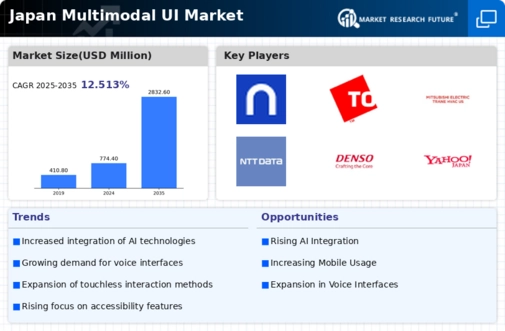Expansion of Smart Device Ecosystems
The expansion of smart device ecosystems in Japan is a critical driver for the multimodal ui market. As households increasingly adopt interconnected devices, the need for interfaces that can manage multiple input modalities becomes paramount. This trend is evident in the rise of smart home technologies, where users expect seamless control over various devices through a single interface. Market data indicates that the smart home market in Japan is projected to reach ¥1 trillion by 2026, further emphasizing the demand for effective multimodal solutions. Companies are now focusing on creating platforms that allow for intuitive interactions across devices, which is likely to enhance user convenience and satisfaction. The integration of multimodal interfaces in these ecosystems is expected to play a pivotal role in shaping consumer behavior and preferences.
Advancements in Voice Recognition Technology
The multimodal ui market in Japan is experiencing a notable surge due to advancements in voice recognition technology. As consumers increasingly prefer hands-free interactions, the demand for systems that can seamlessly integrate voice commands with visual interfaces is rising. This trend is particularly evident in sectors such as automotive and smart home devices, where voice-activated controls enhance user experience. According to recent data, the voice recognition segment is projected to grow at a CAGR of 20% through 2027, indicating a robust market potential. Companies are investing heavily in R&D to improve accuracy and responsiveness, which is likely to further drive adoption in the multimodal ui market. This technological evolution not only enhances user engagement but also aligns with the growing trend of automation in various industries.
Growing Emphasis on Data Privacy and Security
In the context of the multimodal ui market, the growing emphasis on data privacy and security is becoming increasingly relevant in Japan. As users engage with various interfaces that collect personal data, concerns regarding privacy are prompting companies to prioritize secure design practices. This shift is particularly crucial in sectors such as finance and healthcare, where sensitive information is frequently handled. Recent surveys indicate that 70% of consumers in Japan express concerns about data security when using digital interfaces. Consequently, businesses are investing in robust security measures and transparent data handling practices to build trust with users. This focus on privacy is likely to influence the design and functionality of multimodal systems, ensuring that they not only provide a seamless user experience but also safeguard user data.
Increased Demand for Personalized User Experiences
In Japan, the multimodal ui market is witnessing a shift towards personalized user experiences, driven by consumer expectations for tailored interactions. As users become more accustomed to customized content and services, businesses are compelled to adopt multimodal interfaces that can adapt to individual preferences. This trend is particularly significant in e-commerce and entertainment sectors, where personalized recommendations can significantly enhance user satisfaction. Market analysis suggests that companies implementing personalized multimodal systems may see an increase in user retention rates by up to 30%. The ability to combine visual, auditory, and tactile feedback in a cohesive manner is becoming essential for businesses aiming to differentiate themselves in a competitive landscape. Consequently, the focus on personalization is likely to propel growth in the multimodal ui market.
Rise of Augmented and Virtual Reality Applications
The rise of augmented and virtual reality applications is significantly impacting the multimodal ui market in Japan. As these technologies become more mainstream, there is a growing demand for interfaces that can effectively integrate multiple modes of interaction, such as gesture, voice, and touch. Industries such as gaming, education, and training are particularly benefiting from this trend, as immersive experiences require sophisticated multimodal systems to enhance user engagement. Market projections suggest that the AR and VR market in Japan could exceed ¥500 billion by 2025, indicating a substantial opportunity for multimodal ui solutions. Companies are increasingly exploring innovative ways to leverage these technologies, which may lead to the development of new applications and services within the multimodal ui market.
















